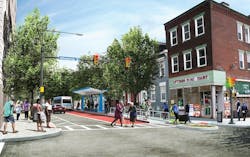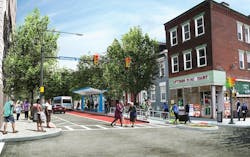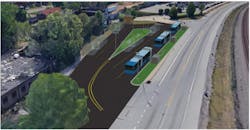Bus rapid transit in Pittsburgh aims to improve city’s sense of community
Traveling the three-mile stretch between downtown Pittsburgh and the city’s Oakland neighborhood has never been more important—or more difficult.
Home to the region’s largest employment center, downtown Pittsburgh also plays host to the region’s cultural epicenter as well as a burgeoning residential and restaurant scene. The city’s Oakland neighborhood long has been home to major universities like the University of Pittsburgh and Carnegie Mellon University, several hospitals, and the region’s second-largest place of employment.
The demand for transit between these corridors is high; buses make up 4% of vehicles but carry more than 50% of the people, but increasing and inconsistent traffic and passenger loads mean that routes are slow, often delayed, and overcrowded.
FINDING A SOLUTION
The solution to maximize transit efficiency while continuing to deliver just as many, if not more, people is bus rapid transit (BRT).
On this BRT project, dedicated bus-only lanes will be implemented in the public right-of-way on Fifth and Forbes Avenues between downtown and Oakland, with three BRT routes operating on this common segment between downtown Pittsburgh and Oakland before branching off into three corridors in the eastern part of the city and suburbs. The nine existing routes in the corridor will be restructured to improve service effectiveness, creating room for growth via transit, a more cost-effective way to add capacity to the network without having to build more right-of-way.
The project includes three branches: the Highland Park Branch that extends 3.4 miles in each direction and the Squirrel Hill Branch that extends 2.9 miles in each direction, both of which will remain mixed-flow; and a third branch extending along the Martin Luther King Jr. East Busway to the Wilkinsburg Station, where a charging station will be constructed. The project will include 43 enhanced/branded stations, dedicated transit lanes, transit signal priority (TSP), smart signal technology, curb bump-outs, a real-time bus arrival information system, off-board fare collection, and the purchase of approximately 25 battery-electric articulated buses.
The BRT routes overlap with the city of Pittsburgh’s Smart Spines, a network of intersections with intelligent traffic signal control. The Smarts Spines Corridors currently include 50 intersections running Surtrac, a real-time, multimodal adaptive traffic signal control system from Rapid Flow Technologies. The Smart Spines system will be expanded, and adaptive signals will be implemented at intersections on Forbes and Fifth Avenues to supplement the BRT routes.
Originally developed in the Robotics Institute at Carnegie Mellon University, the traffic signal system is designed for complex traffic—coordinating transit, pedestrians, bicycles, and cars in grids and complex networks. By estimating dwell times at each stop throughout the day and predicting bus arrival times using connected vehicle technology, Surtrac can improve transit flows in real-time based on actual bus driving behaviors. This approach allows transit flow to be prioritized but balanced with all traffic, and effectively incorporates and optimizes the BRT vehicles and routes.
The existing Surtrac system in Pittsburgh has shown delay reductions of 40%, reduced emissions, 20-30% fewer stops, and improved safety compared to conventional traffic signal control. The BRT routes are expected to produce similar results.
BRT buses will be equipped with dedicated short-range communication (DSRC) radios. Half of the current Surtrac network is also a DSRC connected vehicle testbed used for connected traveler applications such as an accessible cell phone app for disabled pedestrians. This was developed by Carnegie Mellon through the U.S. DOT’s Accessible Transportation Technologies Research Initiative (ATTRI) to improve safety and mobility at signalized intersections. The cell phone app has multiple default choices for speed based on disability (wheelchair, cane, walker, etc.), and it will eventually learn a user’s speed. In addition to requesting a longer period of time before starting to cross, the app can also monitor a user crossing and extend again if they are having problems. All users get a countdown in the app, which enables visually impaired users get an audio countdown and haptic cues.
The electric charging station, planned for Wilkinsburg Station, will include an initial installation of three overhead fast-charging units with space to accommodate another three units for a total of six charging units down the road. Additional charging units will be provided in the nearby bus garage.
A continuous network of bicycle infrastructure improvements will be incorporated throughout the downtown-to-Oakland corridor, which will consist of protected on-street bicycle lanes, a shared sidewalk, and a protected two-way cycle track. Dedicated bicycle facilities will be created to provide safe and effective multimodal transferability and access.
PLANNING & FUNDING
Planning for this project was initiated over several years at the local level, through long-range planning efforts and an alternatives analysis study that identified a wide range of options to execute this effort. While these studies are important in the early proposal development stages for these types of improvements, additional engineering to fully define the project alignment and features was needed to advance the project further. Like many projects of this magnitude, a combination of federal, state, and local funding is necessary to build the BRT system.
The Federal Transit Administration (FTA), which oversees federally funded transit projects, requires any agency seeking federal funds to comply with federal environmental processes and undergo a multiyear, multistep process to become eligible for funding under its nationally competitive, discretionary Capital Investment Grant Program. This program provides funding for Small Starts projects such as this, which include defined stations, short headways, dedicated bus lanes in at least 50% of the corridor, and transit signal priority with a total cost less than $300 million. To qualify for this grant, the project must have entered FTA’s Project Development process and received approval of environmental review documentation, must be seeking less than $100 million in program funds, and must receive an overall rating of at least “medium” in several defined categories.
Engineering firm CDM Smith developed the preliminary engineering plans, oversaw the federal environmental review, and assisted the Port Authority of Allegheny County in entering the project development process and preparing the Small Starts funding application.
Before any project can be approved for federal funding, the National Environmental Policy Act (NEPA), requires consideration and examination of the potential environmental impacts. The NEPA process provides a decision-making framework to consider the purpose and need for a proposed action, potential design solutions, project costs, and relative benefits of a project. As part of the required environmental process, CDM Smith helped to further define the project alignment and design, and oversaw development of a Categorical Exclusion (CE). CEs are used to provide the required environmental documentation for projects which are not anticipated to individually or cumulatively have a significant negative impact to the surrounding community or natural environment. FTA’s approval of the CE in 2018 allowed the project to advance into final design and qualify for federal funding.
Concurrent with this environmental review, the required materials were developed to successfully enter FTA’s Project Development Phase, and a Small Starts Application was prepared for inclusion in the FY 2019 President’s Budget. This information includes details on project benefits and justification as well as anticipated costs and funding sources.
Based on FTA’s evaluation, the project received a “high” rating, making it one of only five currently highly rated projects across the nation. As design plans continue to advance and prior to construction, FTA will issue a full funding grant agreement. This federal funding will help secure nearly half of the required financial support for the project. A series of other state and local funding sources have been identified to meet overall project costs.
COMMUNITY BENEFITS
Currently, bus routes in the area are slow and unpredictable due to increasing and inconsistent traffic and passenger loads. This leads to significant overcrowding, gaps in service, and negatively impacts on-time performance. The buses often get stuck in traffic during heavy commuting times, and passengers experience long waiting periods. Eventually, multiple buses arrive at nearly the exact same time, known as bus bunching. Bus bunching has made the bus system unreliable for passengers; delays range from 10 to 30 minutes regularly. For passengers to plan their day around the transit system, it needs to be timely and reliable. The average weekday ridership along these routes varies between 43,000 and 50,000 riders.
The project’s transit improvements, including improved reliability and accessibility, will benefit the entire community. The BRT system will create a fast, reliable, comfortable, and convenient method of transportation. The branded vehicles and full-featured stations with amenities will increase the appeal of transit to current and potential customers; the faster speeds of the BRT buses will reduce the time traveling through the Downtown-Uptown-Oakland-East End corridor; and the service will be dependable and consistent, with five-minute peak headways and 10-minute off-peak headways. Moreover, the routes are similar to current operations, so passengers already familiar with the bus routes are expected to have an easy transition period as they adjust to the new system.
The system offers the much-needed opportunity for street/sidewalk reconstruction in Uptown—many sidewalks, bus stops, and crosswalks are in poor condition. While these improvements could be addressed separately, a project of this scale will expedite their completion, making the roads safer for cyclists and pedestrians in addition to drivers and transit users.
Investment in fast, reliable transit service will support integrated transportation, land use, and economic goals in the region in a cost-effective way that maximizes existing capacity. And not only will this project improve transit service, it will support anticipated population and employment growth and associated land use development, including residential and commercial development in downtown Pittsburgh, Uptown, Oakland, and East End neighborhoods.
Finally, the BRT system will positively contribute to air quality by using battery-electric buses and by decreased congestion, both by buses and through any mode shift from those using single-occupancy vehicles in the present day.
Construction commences in 2019, and operations are to begin in 2021. This convenient and accessible transit service will not only improve access to and within the Downtown-Uptown-Oakland-East End corridor, but will also provide an array of new opportunities and safety features for the benefit of all residents.



